Long hair remains one of the most versatile and coveted styles, offering endless possibilities for transformation and self-expression.
If you’re searching for inspiration to refresh your look, you’ve landed in the perfect place to discover the Top 30+ Stunning Haircut Ideas for Long Hair in 2025.
This comprehensive guide unveils the most coveted cuts that are dominating salons worldwide, from subtle trims that maintain length to dramatic layered transformations that add movement and dimension.
Whether you’re dreaming of face-framing layers, textured ends, or bold statement cuts, this article walks you through each style with detailed descriptions, styling tips, and maintenance advice.
Get ready to explore cutting-edge trends that will help you find the perfect haircut to complement your face shape, hair texture, and personal style while keeping your beautiful length intact.
Contents
- 1 1. Classic Long Layers
- 2 2. Butterfly Layers
- 3 3. Face-Framing Layers
- 4 4. V-Cut Layers
- 5 5. U-Cut Layers
- 6 6. Shag Layers for Long Hair
- 7 7. Curtain Bangs with Long Layers
- 8 8. Feathered Layers
- 9 9. Blunt Cut with Subtle Layers
- 10 10. Choppy Layered Cut
- 11 11. Sleek One-Length Cut
- 12 12. Layered Lob (Long Bob) Transition
- 13 13. Money Piece Highlights with Layers
- 14 14. Textured Razor Cut
- 15 15. Graduated Layers
- 16 16. Boho Layers with Waves
- 17 17. Asymmetrical Long Layers
- 18 18. Soft Waterfall Layers
- 19 19. Micro Layers at Crown
- 20 20. Diagonal Forward Layers
- 21 21. Invisible Layers
- 22 22. Wispy End Layers
- 23 23. Curved Layered Cut
- 24 24. Stacked Long Layers
- 25 25. Piece-y Textured Layers
- 26 26. Angled Layers
- 27 27. Flipped-Out Layers
- 28 28. Underlayer Cut
- 29 29. Tapered Long Layers
- 30 30. Layered Fringe with Long Hair
- 31 31. Swooped Side Layers
- 32 32. Ribbon Layers
- 33 33. Graduated Bob Transition Layers
- 34 Hair Care Tips for Layered Long Hair
- 35 Styling Tools Essential for Layered Long Hair
- 36 Face Shape Guide for Layered Haircuts
- 37 Seasonal Styling for Layered Long Hair
- 38 Celebrity-Inspired Layered Looks
- 39 Budget-Friendly Layered Hair Maintenance
- 40 Conclusion
1. Classic Long Layers
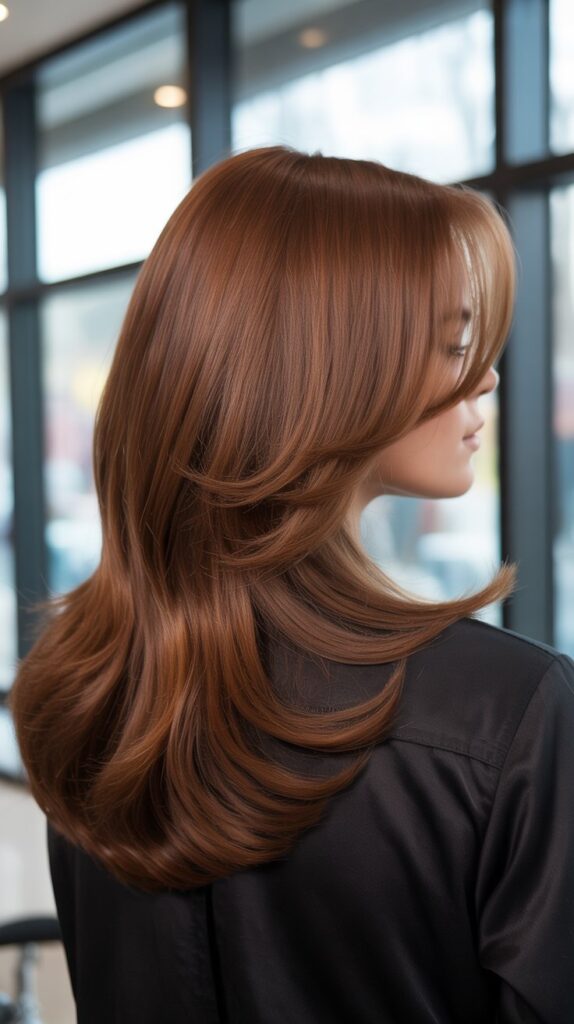
Long layers remain the foundation of timeless elegance and continue to dominate as a go-to choice for those who want dimension without sacrificing length.
This versatile cut works beautifully on all hair textures and provides the perfect balance between structure and movement.
Key Features:
- Layers begin below the shoulders, creating cascading movement that adds volume and bounce to your hair.
- The cutting technique removes weight from thick hair while adding body to fine strands through strategic layering.
- This style frames the face naturally without creating harsh lines or disconnected sections.
- Long layers work exceptionally well for those transitioning from one-length hair who want subtle change.
Styling Tips:
- Apply volumizing mousse to damp hair and blow-dry with a round brush to enhance the layered effect.
- Use a large-barrel curling iron to create loose waves that showcase the dimensional layers.
- For straight styles, run a flat iron through sections while directing hair away from the face.
- Finish with lightweight hairspray to maintain movement without stiffness.
Maintenance Requirements:
- Schedule trims every 10-12 weeks to prevent split ends and maintain the shape.
- Deep condition weekly to keep layers looking healthy and prevent frizz.
- Use heat protectant spray before any thermal styling to preserve hair integrity.
2. Butterfly Layers

Butterfly layers have emerged as the most requested cut in 2025, featuring shorter face-framing pieces that gradually lengthen toward the back, creating a distinctive winged silhouette.
This Instagram-favorite style delivers maximum impact with its dramatic yet wearable shape.
Distinctive Characteristics:
- The shortest layers concentrate around the face, typically starting at cheekbone or chin length.
- Middle sections gradually increase in length, creating a curved, wing-like pattern when viewed from behind.
- The longest pieces remain at the back, maintaining substantial length throughout the cut.
- This technique creates incredible volume at the crown while keeping weight at the ends.
Styling Recommendations:
- Blow-dry with a round brush, focusing on lifting roots for maximum volume at the crown area.
- Curl face-framing layers away from the face using a medium-barrel curling wand.
- Apply texturizing spray to mid-lengths and ends for enhanced definition and separation.
- Consider curtain bangs to complement the butterfly effect and complete the look.
Best Suited For:
- Individuals with oval, heart-shaped, or diamond face shapes who want to soften angular features.
- Those with fine to medium hair texture seeking volume and movement.
- People ready for a noticeable transformation while maintaining significant length.
3. Face-Framing Layers
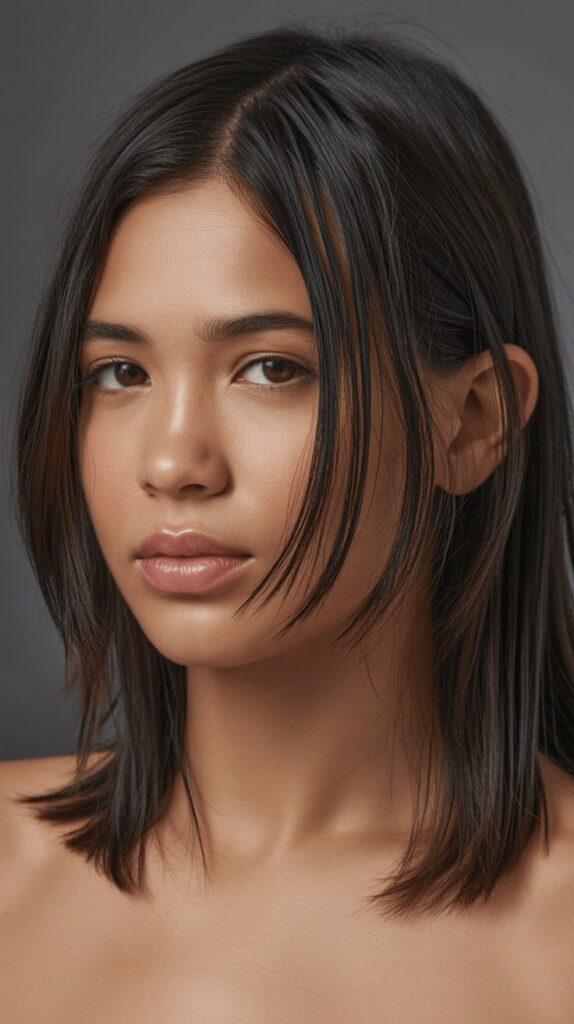
Face-framing layers strategically place shorter pieces around the face while keeping the rest of the hair long and relatively uniform in length.
This targeted approach brightens your features and adds softness without committing to an all-over layered look.
Cut Specifications:
- Layers concentrate exclusively around the face, starting anywhere from cheekbone to collarbone length.
- The back and sides remain mostly one-length, creating a clear distinction between framed and unframed sections.
- Stylist customizes the starting point based on your face shape and desired effect.
- This precision cut requires expert sectioning to achieve the most flattering results.
Styling Variations:
- Blow-dry face-framing pieces with a small round brush, directing them slightly away from the face.
- Use a flat iron to create subtle bends or waves in the front pieces for added texture.
- Leave the back straight for a sleek, polished contrast to the textured front.
- Apply shine serum to the lengths while keeping texture spray concentrated on the framing layers.
Advantages:
- Minimal maintenance compared to full layered cuts while delivering significant visual impact.
- Easily customizable to flatter specific facial features you want to emphasize or soften.
- Provides styling versatility for both casual and formal occasions.
- Grows out gracefully without creating awkward in-between stages.
4. V-Cut Layers
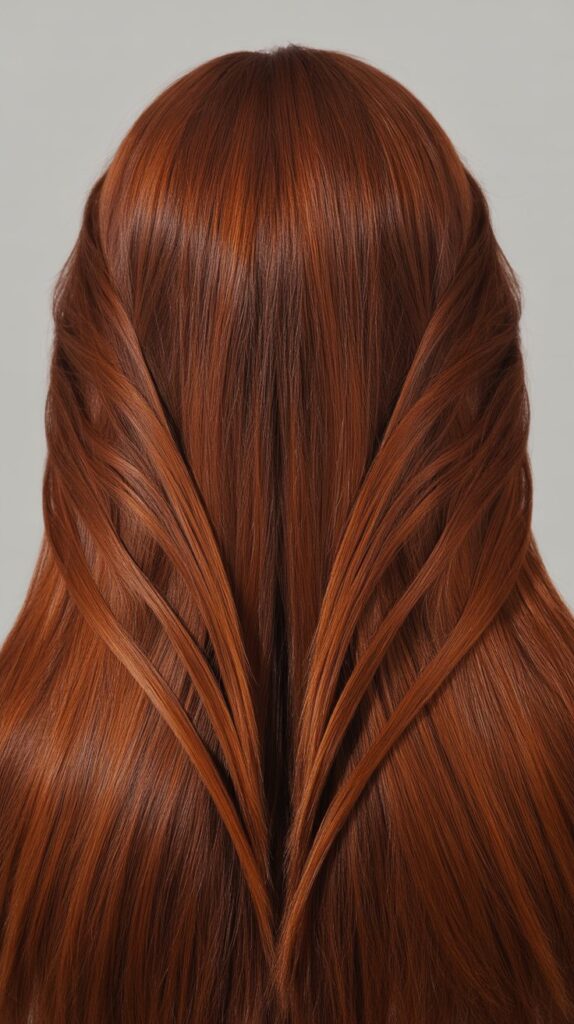
The V-cut creates a distinctive pointed shape at the back, forming a dramatic V when hair is viewed from behind.
This geometric cut adds architectural interest to long hair while maintaining significant length at the center back.
Technical Details:
- Hair gradually shortens from the center back toward the sides, creating the signature V-shape.
- The angle of the V can be adjusted from subtle to dramatic based on personal preference.
- Layers may be added throughout for additional movement or kept minimal for a sleek look.
- This cut works particularly well on thick, dense hair that can support the geometric shape.
Styling Methods:
- Straighten hair completely to showcase the precise V-shape and clean lines.
- Curl hair with a curling iron, allowing the V-shape to create a beautiful curved pattern.
- Braid hair to emphasize the tapered point at the bottom of the V.
- Apply smoothing serum to eliminate frizz and highlight the cut’s precision.
Visual Impact:
- Creates a slimming effect on the overall silhouette when hair is worn down.
- The pointed shape draws attention to the length and creates a polished, intentional appearance.
- Works beautifully in updos, allowing the V-shape to peek through braids and twists.
5. U-Cut Layers
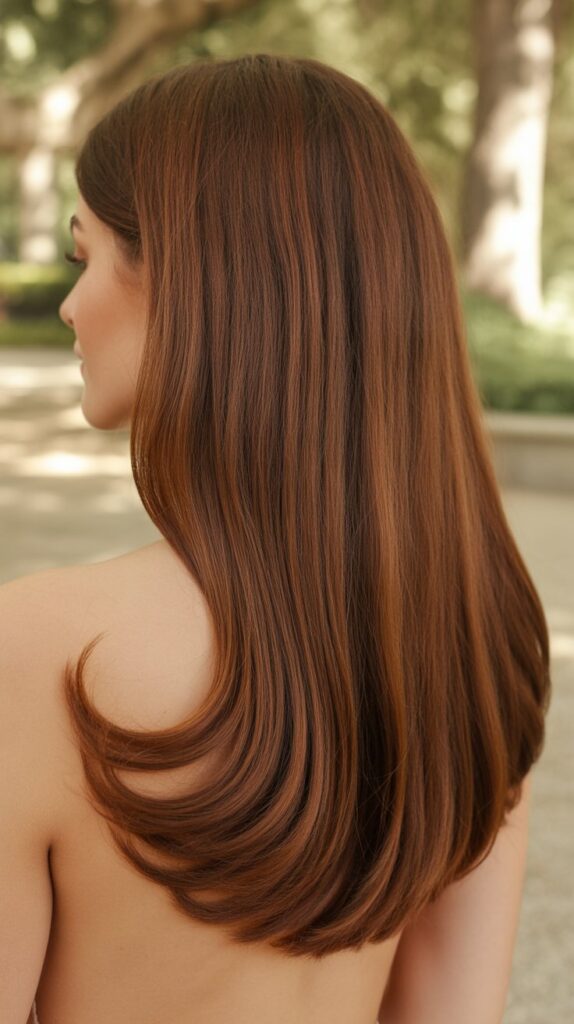
The U-cut forms a gentle, rounded hemline that creates a softer alternative to blunt cuts while still maintaining fullness at the ends.
This feminine shape flatters most face types and hair textures.
Cut Characteristics:
- Hair forms a gradual U-shape or curve at the bottom, with the shortest pieces at the sides.
- The center back remains the longest point, creating fullness and weight at the ends.
- Subtle layering can be incorporated throughout without disrupting the curved hemline.
- The rounded shape appears natural and prevents harsh, blunt lines.
Application Techniques:
- Blow-dry with a paddle brush to maintain smoothness and emphasize the rounded shape.
- Add loose curls or waves that enhance the U-curve and create romantic movement.
- Pin up one side to showcase the dimensional curve from different angles.
- Use a boar bristle brush to distribute natural oils and create shine along the curve.
Perfect For:
- Those who want to soften the appearance of a blunt cut without adding dramatic layers.
- Individuals with fine hair seeking to maintain the illusion of fullness at the ends.
- People who prefer low-maintenance styles that look intentional as they grow.
6. Shag Layers for Long Hair

The modern long shag brings 1970s-inspired texture into 2025 with updated techniques that create effortless, lived-in appeal.
This heavily layered cut combines shorter crown layers with longer lengths for a perfectly imperfect aesthetic.
Defining Elements:
- Multiple layers throughout the hair create maximum texture and movement from roots to ends.
- Crown layers are significantly shorter, often starting at chin length or above.
- Choppy, piece-y ends replace blunt lines for an undone, rock-and-roll vibe.
- The cut intentionally looks tousled and relaxed rather than perfectly polished.
Styling Approach:
- Enhance natural texture by scrunching damp hair with sea salt spray or texturizing mousse.
- Air-dry for the most authentic shag appearance, embracing natural waves and bends.
- Use a diffuser attachment if blow-drying to maintain texture while adding volume.
- Rough-dry with fingers instead of brushes to preserve the deliberately messy aesthetic.
Ideal Candidates:
- Those with naturally wavy or textured hair that embraces the shag’s tousled nature.
- Individuals seeking a low-maintenance cut that looks stylish without extensive daily styling.
- Anyone wanting to add significant volume and movement to thick, heavy hair.
7. Curtain Bangs with Long Layers
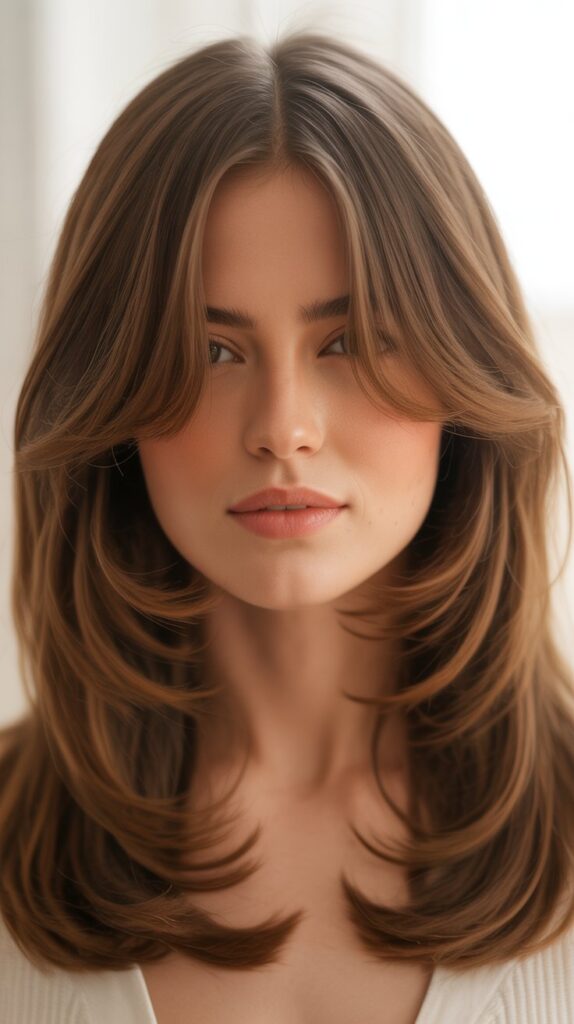
Curtain bangs paired with long layers create a soft, romantic look that has become synonymous with effortless French-girl style.
The face-framing bangs part in the center and blend seamlessly into layered lengths.
Bang Specifications:
- Bangs part down the middle and sweep to each side, framing the face like curtains.
- The bangs typically start at eyebrow level or slightly longer, curving away from the face.
- They gradually blend into the first layer of the haircut without creating a harsh line.
- The length and curve can be customized to flatter different face shapes.
Integration with Layers:
- Long layers begin where the curtain bangs end, creating seamless flow and movement.
- The layers throughout the length complement the soft, romantic vibe of the bangs.
- This combination works on straight, wavy, and curly hair with proper customization.
Styling Requirements:
- Blow-dry bangs with a round brush, directing them away from the center part.
- Use a flat iron or curling wand to add a gentle bend that enhances the curtain effect.
- Apply lightweight styling cream to prevent bangs from looking stiff or separated.
- Regular bang trims every 3-4 weeks maintain the perfect length and shape.
8. Feathered Layers
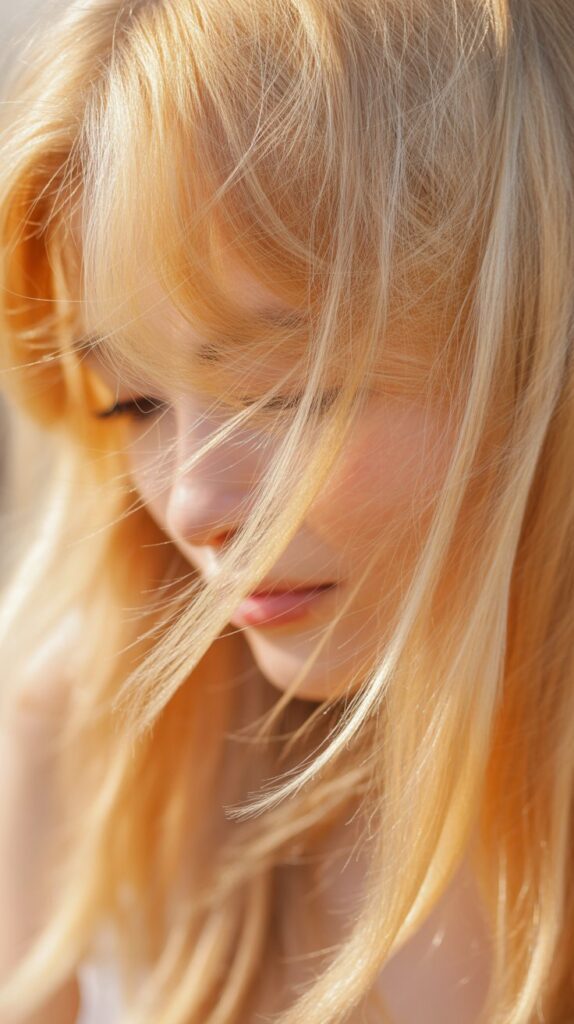
Feathered layers bring a textured, wispy quality to long hair through a specialized cutting technique that creates soft, feather-like ends.
This technique adds airiness and movement while reducing bulk.
Technical Approach:
- Hair is point-cut or razor-cut to create soft, tapered ends that resemble feathers.
- Layers are distributed throughout the hair, with each section receiving the feathering technique.
- The cutting angle varies to create maximum texture and prevent blunt edges.
- This method works especially well for removing weight from thick, heavy hair.
Texture Enhancement:
- The feathered ends catch light differently than blunt cuts, creating dimensional appeal.
- Movement is amplified as the wispy ends move independently with each head turn.
- Hair appears lighter and more voluminous due to the reduced weight at the ends.
Styling Options:
- Blow-dry with fingers rather than brushes to maintain the feathered, piece-y texture.
- Apply texturizing products to damp hair to enhance separation and definition.
- Use a diffuser for wavy or curly hair to preserve the feathered pattern.
- Avoid heavy products that would weigh down the delicate, wispy ends.
9. Blunt Cut with Subtle Layers
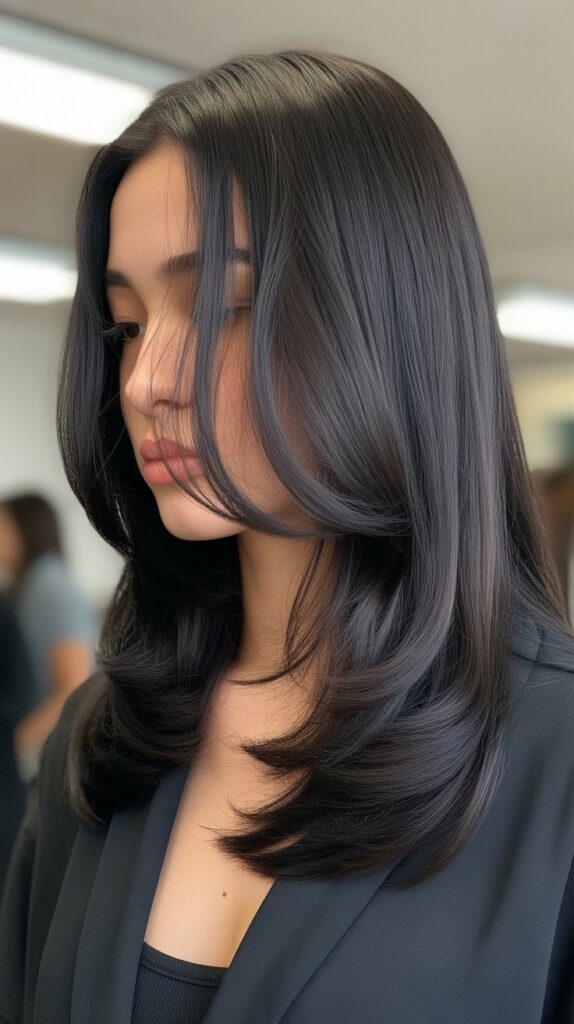
A blunt cut with subtle internal layers provides the appearance of thick, healthy ends while incorporating hidden layers for movement and manageability.
This sophisticated hybrid approach delivers the best of both cutting styles.
Structural Design:
- The perimeter remains blunt and even, creating a solid, weighty appearance at the hemline.
- Internal layers are cut throughout the interior of the hair without affecting the outer edge.
- These hidden layers remove bulk and add movement without compromising the blunt appearance.
- The technique requires precision to maintain the blunt outline while strategically layering within.
Benefits of This Approach:
- Hair appears fuller and thicker due to the preserved blunt edge.
- Internal layers prevent the haircut from becoming too heavy or triangular in shape.
- Styling becomes easier as the internal layering allows for better product distribution.
- The cut grows out beautifully, maintaining its shape for extended periods between salon visits.
Styling Guidance:
- Use a paddle brush when blow-drying to emphasize the smooth, blunt perimeter.
- Add beach waves or loose curls that showcase the internal movement without disrupting the ends.
- Apply glossing treatments to maximize shine along the blunt edge.
- Flat iron in sections for a sleek look that highlights the precision of the cut.
10. Choppy Layered Cut

Choppy layers inject edgy, modern energy into long hair through deliberately uneven, textured cutting techniques.
This bold style creates dramatic dimension and works particularly well for those wanting a fashion-forward look.
Cutting Technique:
- Layers are cut at varying lengths with intentional irregularity rather than uniform graduation.
- Point-cutting or slide-cutting creates jagged, piece-y ends throughout the hair.
- The choppy sections are distributed strategically to create movement and remove weight.
- This technique embraces imperfection and creates an artfully undone appearance.
Visual Effect:
- Hair appears to have more texture and dimension than traditional layered cuts.
- The uneven layers catch light differently, creating enhanced depth and visual interest.
- Movement is maximized as the varying lengths respond differently to styling and gravity.
Styling Requirements:
- Embrace natural texture by applying texturizing spray to damp hair before air-drying.
- Use a curling wand on random sections rather than uniform curls for added choppiness.
- Scrunch hair while drying to enhance the piece-y, separated effect.
- Avoid smoothing products that would diminish the intentionally rough texture.
11. Sleek One-Length Cut

The one-length cut represents minimalist sophistication, featuring hair cut to a uniform length without layers or graduation.
This clean, geometric style emphasizes hair health and natural shine.
Cut Characteristics:
- All hair is cut to exactly the same length, creating a horizontal line at the bottom.
- No layers are incorporated, maintaining uniform weight distribution from roots to ends.
- The precision cut creates a polished, intentional appearance that looks sharp and modern.
- This style works best on straight to slightly wavy hair that can showcase the clean line.
Maintenance Considerations:
- Regular trims every 6-8 weeks are essential to maintain the precise line and prevent split ends.
- Deep conditioning treatments preserve the sleek appearance and prevent frizz along the edges.
- Hair masks and glossing treatments enhance shine, which is crucial for this style’s success.
Styling Methods:
- Blow-dry with a paddle brush, pulling hair taut to create maximum smoothness.
- Flat iron in small sections to achieve glass-like shine and perfectly straight results.
- Apply smoothing serum or oil to eliminate any texture or flyaways.
- Consider keratin treatments for those who want long-lasting sleekness with minimal daily effort.
12. Layered Lob (Long Bob) Transition

The layered lob serves as the perfect transitional cut for those contemplating shorter hair while keeping substantial length.
This style falls between the collarbone and shoulders, offering versatility and modern appeal.
Length Specifications:
- Hair is cut to fall anywhere between the collarbone and a few inches past the shoulders.
- Layers are incorporated throughout to prevent the blunt, heavy appearance of a traditional bob.
- Face-framing pieces can be customized shorter or longer based on face shape preferences.
- This length provides styling flexibility for both wearing hair down and creating updos.
Versatility Factors:
- The length works beautifully with straight, wavy, and curly hair textures when properly cut.
- Both center and side parts look flattering, offering daily variation options.
- Hair can be tucked behind ears for a casual look or styled with volume for formal occasions.
Styling Variations:
- Create loose waves with a curling wand for effortless, beachy texture.
- Straighten for a sleek, professional appearance appropriate for any setting.
- Add texture spray and tousle for an undone, modern aesthetic.
- Experiment with half-up styles, low ponytails, and simple braids.
13. Money Piece Highlights with Layers
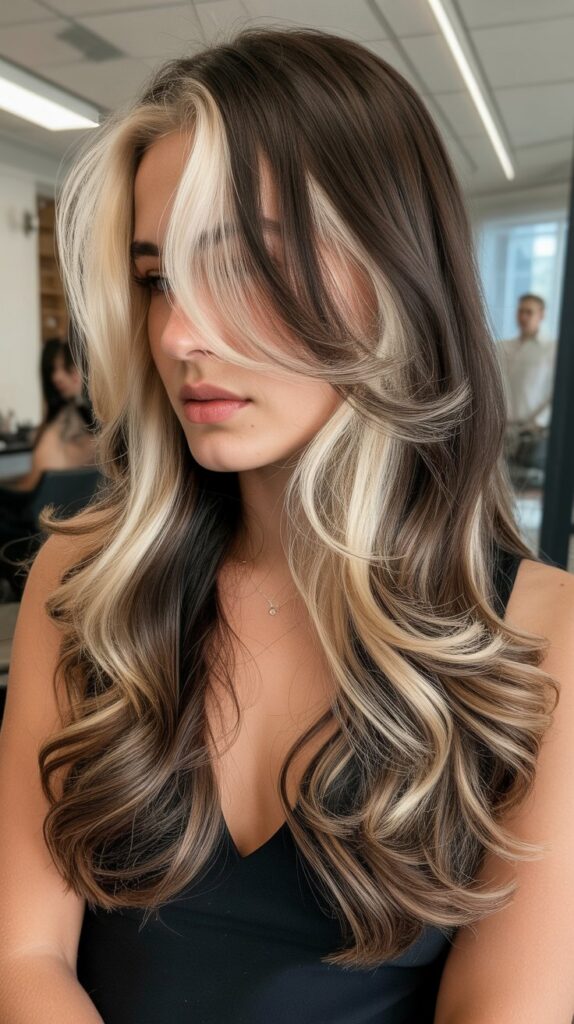
Money piece highlights combined with long layers create dimension through both color and cut, featuring bright face-framing highlights that complement layered textures.
This combination maximizes visual impact and adds brightness to your complexion.
Color Placement:
- Two thick highlights are placed directly in the front, framing each side of the face.
- These pieces are typically 2-3 shades lighter than the base color for maximum contrast.
- The highlights begin at or near the root and extend through the entire face-framing section.
- This strategic placement brightens the face and draws attention to your features.
Integration with Layers:
- Long layers are cut to showcase the dimensional color placement throughout the hair.
- Face-framing layers highlight the money piece even more effectively.
- The layers create movement that allows the contrasting colors to catch light dynamically.
Maintenance Requirements:
- Touch-ups are needed every 6-8 weeks to maintain the bright, fresh appearance of the money piece.
- Purple shampoo helps maintain cool tones and prevent brassiness in blonde money pieces.
- Deep conditioning treatments preserve the health of highlighted sections.
14. Textured Razor Cut
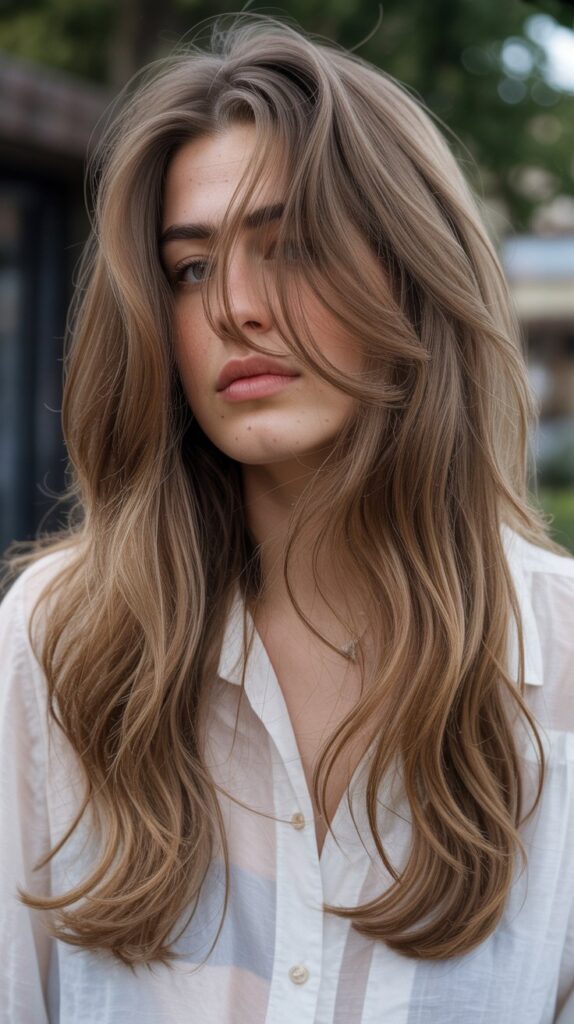
Razor cutting creates soft, textured layers through a specialized cutting tool that produces wispy, feathered ends.
This technique adds movement and reduces bulk while creating a lived-in, effortless appearance.
Razor Cutting Technique:
- A straight razor replaces traditional shears to cut hair at an angle rather than blunt.
- The razor creates tapered, thinned ends that appear softer and more natural than scissor-cut hair.
- This method removes weight while simultaneously creating texture throughout the hair.
- The technique works especially well on thick, dense hair that needs lightening.
Texture Benefits:
- Hair moves more freely due to the reduced weight and tapered ends.
- The soft texture prevents harsh lines and creates a more organic, natural appearance.
- Styling products absorb better into razor-cut hair, enhancing texture and definition.
Considerations:
- Razor cutting works best on straight to wavy hair; curly hair may become too frizzy.
- The technique requires a skilled stylist experienced with razor cutting methods.
- Hair should be in good condition before razor cutting, as damaged hair may split further.
15. Graduated Layers
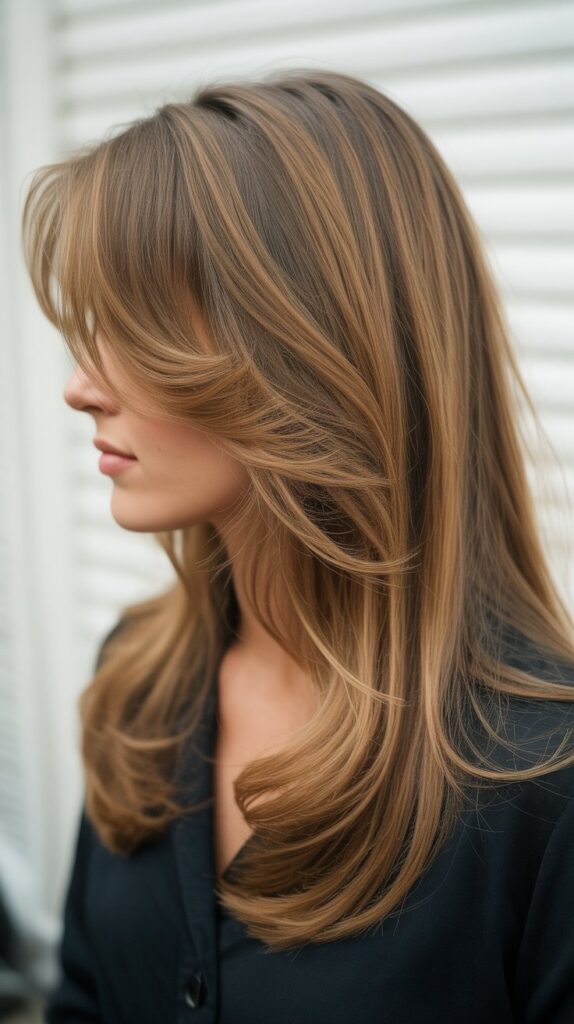
Graduated layers create a stacked effect where layers are cut progressively shorter from bottom to top, building volume at the crown while maintaining length at the bottom.
This technique adds body and dimension to long hair.
Layer Structure:
- The shortest layers concentrate at the crown, creating height and volume in that area.
- Each subsequent layer increases in length, forming a gradual graduation down to the longest pieces.
- The graduation creates a rounded, voluminous silhouette rather than flat or limp appearance.
- This cutting technique adds fullness where needed while maintaining length.
Volume Enhancement:
- Crown layers lift away from the head, creating natural height and body.
- The stacked effect prevents hair from lying flat against the scalp.
- Blow-drying becomes easier as the graduated layers naturally want to lift and separate.
Styling Techniques:
- Focus blow-drying efforts at the crown, using a round brush to enhance the built-in volume.
- Add loose curls to the mid-lengths and ends to complement the graduated shape.
- Use volumizing products at the roots where the shortest layers begin.
- Avoid weighing down the crown layers with heavy oils or serums.
16. Boho Layers with Waves
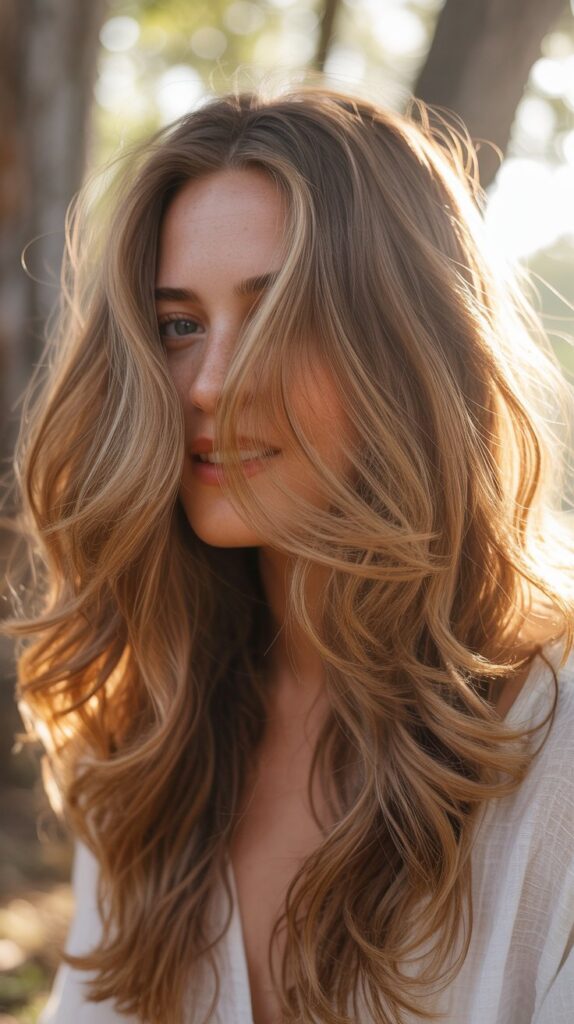
Boho layers combine flowing, romantic layers with naturally textured waves to create an effortlessly chic, free-spirited aesthetic.
This style embraces natural texture and movement for a relaxed, festival-ready appearance.
Layer Placement:
- Layers are distributed throughout the hair in a loose, unstructured pattern.
- The cutting technique prioritizes softness over precision, creating organic flow.
- Face-framing pieces begin around the cheekbones, softening facial features.
- Longer layers maintain substantial length while adding movement throughout.
Wave Integration:
- Natural or styled waves enhance the bohemian aesthetic and showcase the layers.
- The combination of layers and waves creates maximum dimension and texture.
- This style works beautifully with air-dried natural texture or styled waves.
Styling Approach:
- Apply sea salt spray or texturizing cream to damp hair before scrunching.
- Air-dry or diffuse hair to enhance natural wave patterns.
- Use a curling wand on random sections rather than uniform curls for organic appearance.
- Embrace imperfection and avoid over-styling for authentic boho appeal.
17. Asymmetrical Long Layers

Asymmetrical layers create intentional imbalance through uneven cutting that features different lengths on each side.
This bold, artistic approach adds edge and personality to long hair.
Design Concept:
- One side of the hair is cut noticeably longer or shorter than the other side.
- Layers may be concentrated more heavily on one side for additional asymmetry.
- The imbalance can be subtle or dramatic depending on personal preference and lifestyle.
- This style makes a strong fashion statement and showcases individual creativity.
Styling Considerations:
- The asymmetry naturally draws the eye and creates visual interest without additional styling.
- Side-parting enhances the asymmetrical effect and showcases the different lengths.
- Styling one side behind the ear while leaving the other side down emphasizes the cut.
Maintenance Notes:
- Asymmetrical cuts require precise maintenance trims to preserve the intentional imbalance.
- Growing out this style requires patience and potentially transitional cuts.
- Regular salon visits ensure the asymmetry remains sharp and intentional.
18. Soft Waterfall Layers
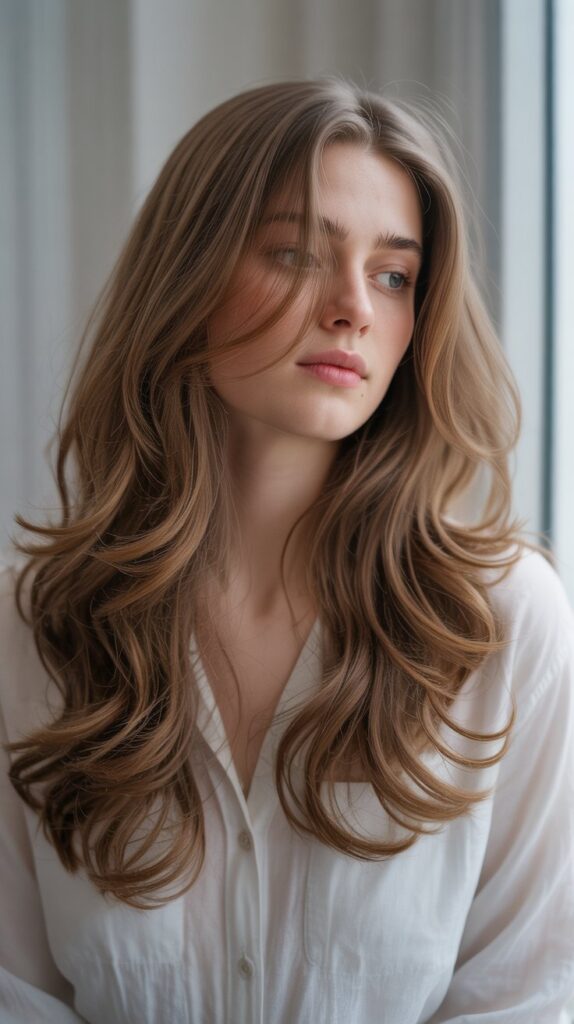
Waterfall layers cascade down the hair in gentle, flowing tiers that mimic the movement of water.
This romantic cutting technique creates seamless transitions between layer lengths for ultra-feminine appeal.
Layer Flow:
- Layers flow into each other without harsh demarcation lines or visible separation.
- The cutting technique creates smooth, gradual transitions that resemble cascading water.
- Multiple layers are incorporated throughout, each blending seamlessly into the next.
- This style prioritizes softness and fluidity over structured, defined layers.
Romantic Aesthetic:
- The flowing layers create a dreamy, ethereal appearance that photographs beautifully.
- Movement is enhanced as the layers respond to every head turn and breeze.
- This cut works particularly well for weddings, special events, and romantic styling.
Styling Methods:
- Loose, flowing curls or waves complement the cascade effect of the layers.
- Blow-dry with a large round brush to maintain smoothness while adding body.
- Apply lightweight styling products that won’t disrupt the flowing nature of the cut.
- Half-up hairstyles showcase the waterfall effect beautifully.
19. Micro Layers at Crown
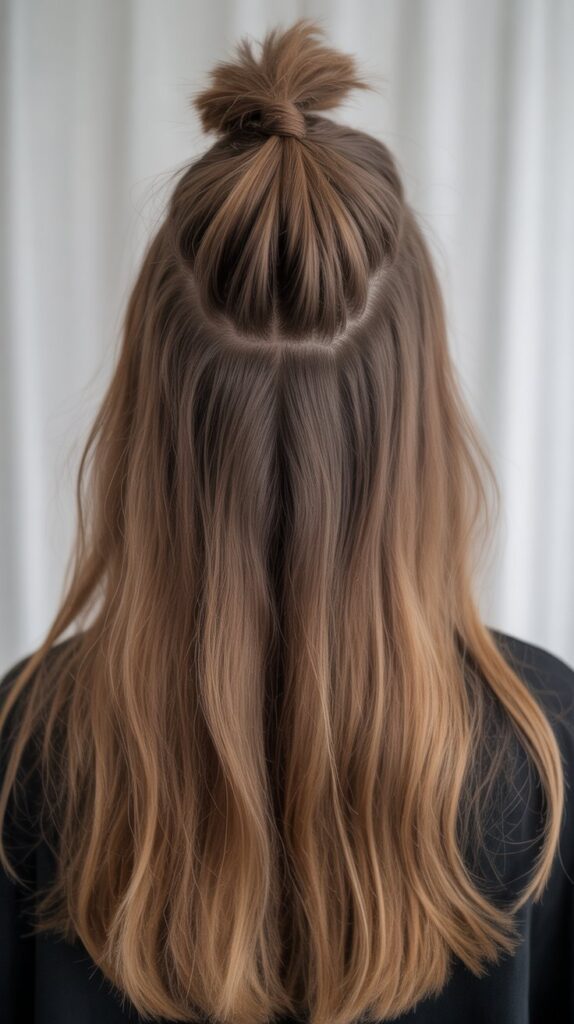
Micro layers concentrate very short, subtle layers at the crown while keeping the rest of the hair long and relatively uniform.
This targeted approach adds volume at the roots without dramatically changing overall length.
Crown Layering Technique:
- Short layers are cut exclusively at the crown area, typically 2-4 inches in length.
- These micro layers create lift and volume where hair often falls flat.
- The surrounding hair remains significantly longer, creating a concealed layering effect.
- This technique works well for fine or flat hair that lacks natural volume.
Volume Creation:
- The short crown layers stand up and away from the scalp, creating height.
- Longer surrounding layers camouflage the shorter pieces when styled down.
- Blow-drying becomes easier as the micro layers naturally want to lift.
Styling Techniques:
- Focus volumizing products specifically at the crown where micro layers exist.
- Blow-dry crown layers with a round brush, lifting at the roots.
- The rest of the hair can be styled straight or curled based on preference.
- Teasing crown layers gently adds additional height for special occasions.
20. Diagonal Forward Layers
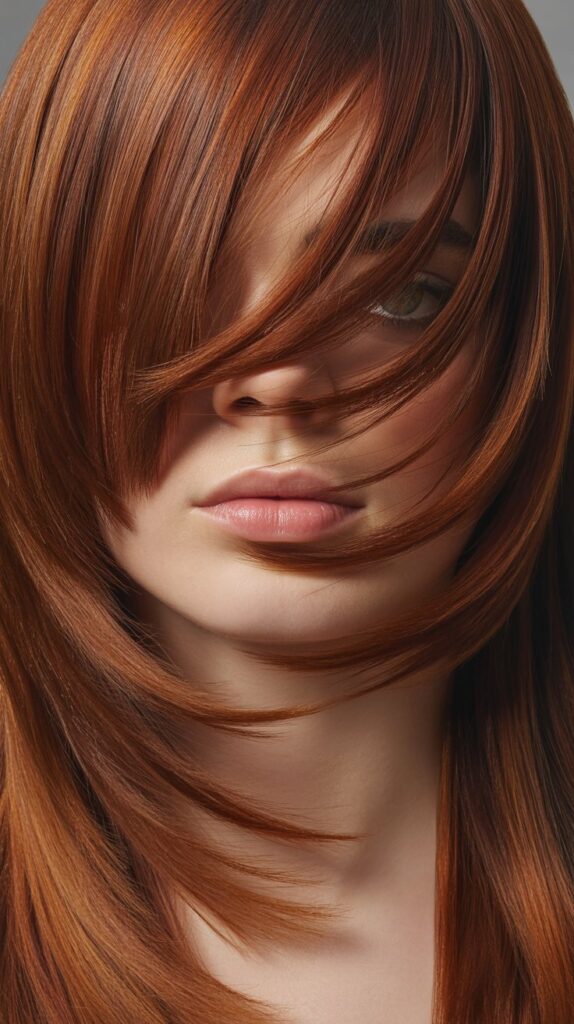
Diagonal forward layers are cut at an angle that brings shorter pieces toward the front of the face, creating a directional flow that frames features and adds interest.
This geometric approach adds modern edge to long hair.
Cutting Angle:
- Hair is sectioned and cut at a forward diagonal angle rather than straight across.
- The shortest pieces fall near the face, with lengths gradually increasing toward the back.
- This creates a sweeping effect that draws the eye forward and frames the face.
- The angle can be adjusted from subtle to dramatic based on desired impact.
Directional Benefits:
- The forward angle creates face-framing effects without separate, distinct face-framing layers.
- Hair naturally falls toward the face, eliminating the need for extensive styling.
- The geometric precision adds modern, architectural interest to the haircut.
Styling Options:
- Blow-dry following the natural forward direction of the layers for seamless results.
- Curl hair away from the face to create contrast with the forward-cut layers.
- The diagonal cut looks beautiful both straight and wavy, offering versatility.
21. Invisible Layers
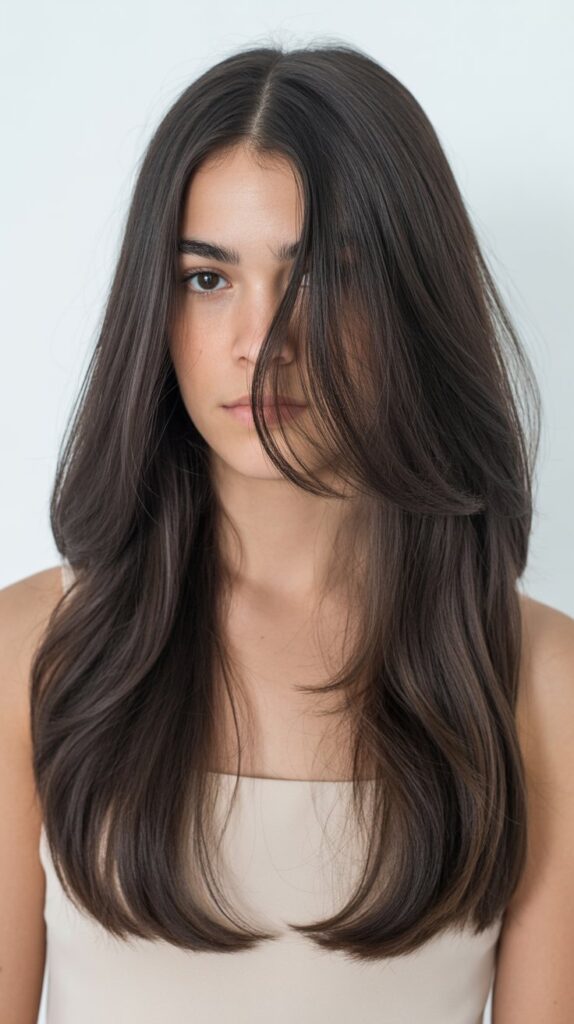
Invisible layers provide the benefits of layered hair—movement, volume, and texture—while maintaining the appearance of one-length hair.
This subtle technique removes weight without creating visible layering lines.
Cutting Method:
- Layers are cut using advanced techniques that blend seamlessly into the overall length.
- The layering occurs internally and throughout the hair without disrupting the perimeter shape.
- Point-cutting and slicing techniques create texture without obvious layer demarcation.
- From the outside, hair appears to be one length while behaving like layered hair.
Advantages:
- Hair retains the fullness appearance of a one-length cut while gaining layered benefits.
- Movement and manageability improve without sacrificing visual thickness.
- This technique works exceptionally well for those hesitant about visible layers.
Maintenance:
- Regular trims maintain the seamless blend of the invisible layers.
- The cut grows out beautifully without creating awkward in-between stages.
- Minimal styling is required as the invisible layers provide natural movement.
22. Wispy End Layers
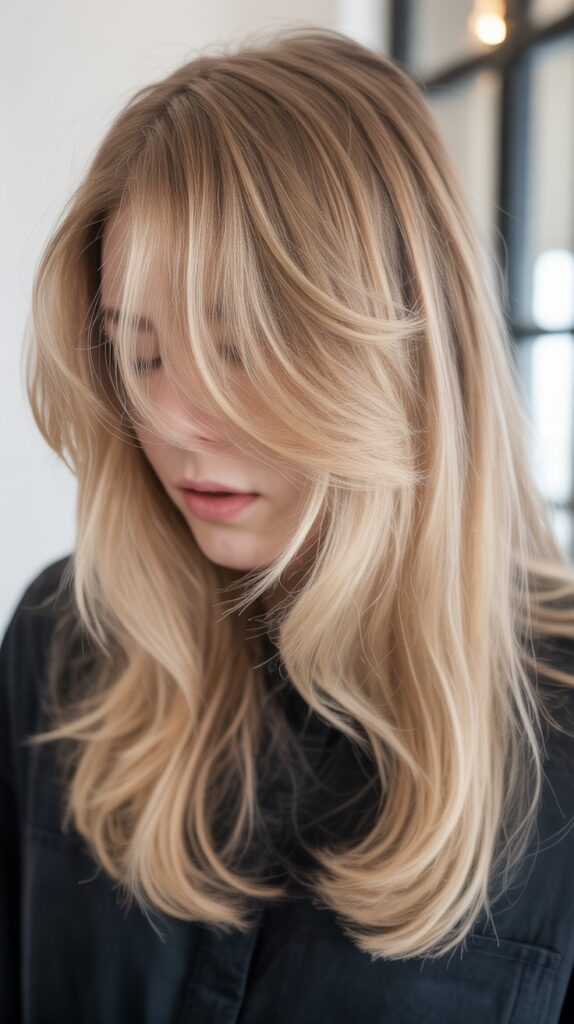
Wispy end layers focus texture and layering exclusively at the bottom few inches of hair, creating delicate, feather-like tips while keeping the bulk of hair long and full.
This approach adds softness without compromising length.
Layer Concentration:
- Layering occurs only in the bottom 3-5 inches of hair, leaving the rest uniform in length.
- Ends are point-cut or razor-cut to create thin, wispy, textured tips.
- The bulk of the hair remains full and heavy, with texture concentrated at the ends.
- This technique prevents blunt, harsh lines at the hemline while maintaining length.
Textural Quality:
- Ends appear soft, delicate, and ethereal rather than solid and blunt.
- The wispy texture catches light differently, creating dimensional movement.
- Hair appears less heavy and more free-flowing due to the textured ends.
Styling Considerations:
- The wispy ends require minimal styling and often look best with natural texture.
- Avoid heavy products at the ends that would weigh down the delicate tips.
- Air-drying works well with this cut, as the wispy ends create natural texture.
23. Curved Layered Cut

The curved layered cut combines the shape of a U-cut hemline with internal layers throughout, creating dimensional roundness and movement.
This hybrid approach delivers both structural shape and flowing texture.
Structural Design:
- The perimeter forms a gentle U-shape with shortest pieces at sides and longest at center back.
- Internal layers are distributed throughout the hair, adding movement within the curved shape.
- The combination creates a rounded, full silhouette that appears deliberately shaped.
- This technique prevents triangular or pyramid-shaped appearance in thick hair.
Dimensional Quality:
- The curved perimeter creates visual interest when viewed from behind or in motion.
- Internal layers add dimension that prevents the hair from appearing flat or one-dimensional.
- Both the shape and layering work together to create a polished, complete look.
Styling Methods:
- Blow-dry with attention to the curved shape, enhancing the rounded silhouette.
- Add waves or curls that follow and complement the U-shaped curve.
- Straightening showcases the precision of both the curve and internal layers.
24. Stacked Long Layers

Stacked long layers feature shorter layers that progressively stack upon each other at the crown and back, creating built-in volume while maintaining length at the perimeter.
This technique adds fullness without sacrificing length.
Stacking Technique:
- Multiple short layers are cut at the crown, each sitting atop the one below it.
- Layers gradually increase in length moving down the head toward the perimeter.
- The stacking creates natural lift and volume in areas that typically fall flat.
- This approach works particularly well for fine hair that needs body and fullness.
Volume Benefits:
- The stacked layers create automatic height at the crown without extensive styling.
- Hair appears fuller and thicker due to the dimensional stacking effect.
- Blow-drying is simplified as the cut naturally wants to lift and separate.
Styling Requirements:
- Focus on drying the crown layers first, using a round brush to enhance volume.
- Volumizing products applied at the roots amplify the stacking effect.
- The perimeter can be styled straight, wavy, or curly based on preference.
25. Piece-y Textured Layers
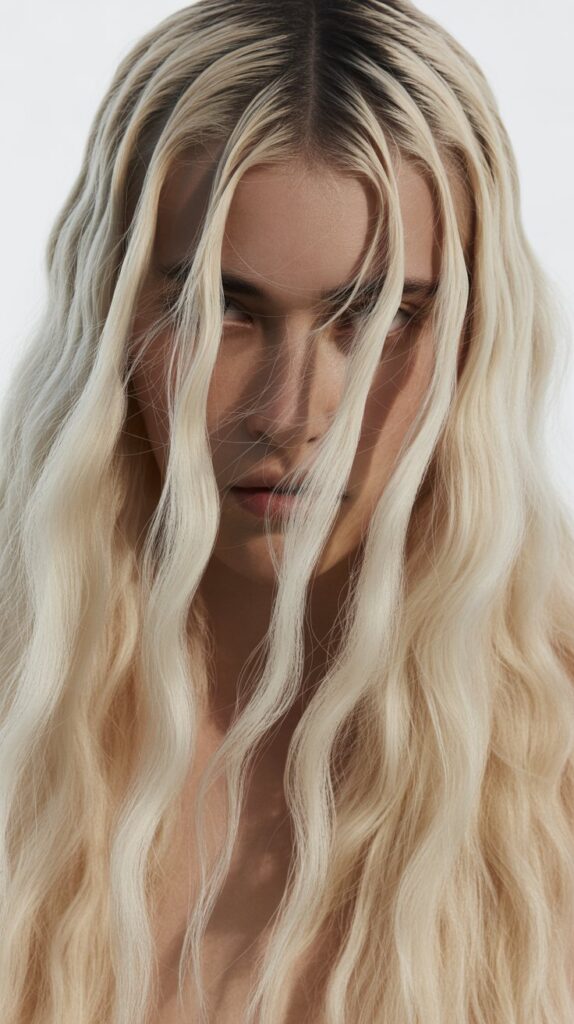
Piece-y textured layers create separated, defined sections throughout the hair rather than blended, cohesive layers.
This modern technique emphasizes individual strands and creates editorial, high-fashion appeal.
Cutting Approach:
- Hair is cut using point-cutting or slicing techniques that create separation between sections.
- Layers are cut with intentional gaps and unevenness to create a piece-y, separated effect rather than smooth transitions.
- The technique removes weight while creating distinct texture and definition throughout the hair.
- This style embraces the “undone” aesthetic popular in contemporary fashion and editorial work.
Textural Definition:
- Individual sections of hair are visible and defined rather than blending together seamlessly.
- The separated pieces create visual interest and dimension that photographs exceptionally well.
- Movement is maximized as each piece responds independently to styling and movement.
- Light reflects differently off the separated sections, creating enhanced dimensional appeal.
Styling Methods:
- Apply texturizing paste or clay to dry hair, separating pieces with your fingers.
- Avoid brushing through the hair, which would diminish the piece-y separation.
- Use sea salt spray on damp hair and scrunch to enhance the textured, separated look.
- Air-drying or diffusing works better than blow-drying for maintaining the piece-y effect.
Best Candidates:
- Those with naturally textured or wavy hair that holds piece-y definition well.
- Individuals seeking an edgy, fashion-forward look with minimal daily styling.
- People comfortable with an intentionally messy, undone aesthetic.
26. Angled Layers
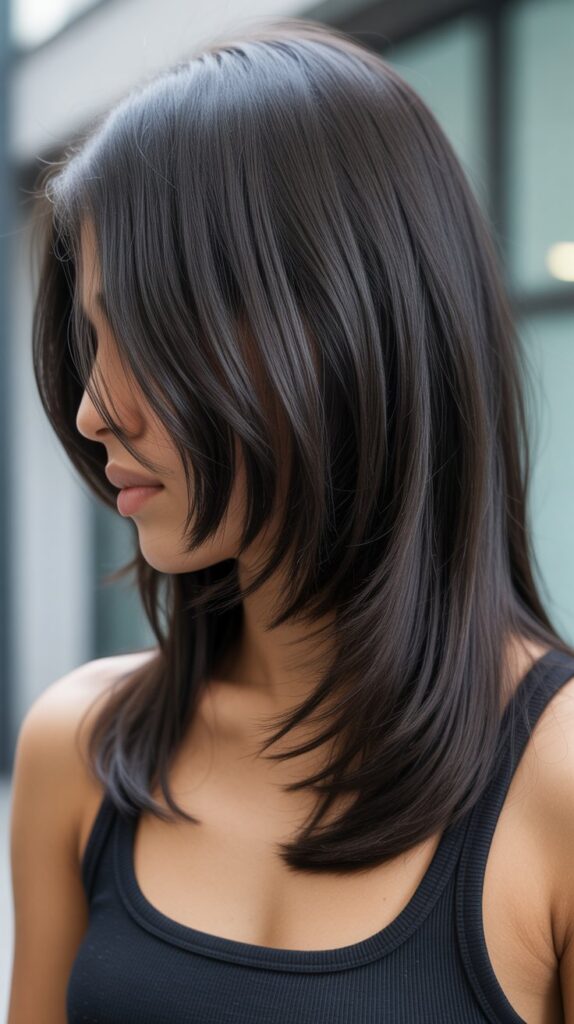
Angled layers feature cutting that creates a diagonal line from front to back, with the front pieces significantly shorter than the back.
This directional cutting adds drama and modern edge to long hair.
Angular Design:
- Hair is cut at a pronounced angle, creating the shortest pieces near the face.
- The angle increases gradually from front to back, with the longest hair at the center back.
- This creates a sharp, geometric effect that makes a bold style statement.
- The degree of angle can be customized from subtle to extremely dramatic.
Visual Impact:
- The angled cut draws attention to the face and creates a framing effect.
- When viewed from the side, the dramatic angle creates architectural interest.
- The style looks intentional and fashion-forward rather than accidental or grown-out.
Styling Versatility:
- Straightening emphasizes the precision and sharpness of the angled cut.
- Curling softens the geometric lines while maintaining the directional flow.
- Side-parting enhances the angle by showing the length difference more dramatically.
- Wearing hair behind one ear showcases the angular cut from a different perspective.
27. Flipped-Out Layers

Flipped-out layers feature ends that curl away from the face and neck, creating a retro-inspired look with modern appeal.
This playful style adds volume and personality to long layered hair.
Styling Characteristics:
- Ends of the layers are curled or blown-dry to flip outward rather than under.
- The flipped effect works best on layers that fall between chin and shoulder length.
- Multiple layers can be flipped for maximum volume and retro flair.
- This style references 1960s and 1970s aesthetics with contemporary updating.
Creating the Flip:
- Use a medium round brush while blow-drying, rolling the brush outward at the ends.
- A curling iron can create more pronounced flips by wrapping hair away from the face.
- Velcro rollers set in the outward direction create lasting flipped volume.
- Finish with flexible-hold hairspray to maintain the flip without stiffness.
Personality Expression:
- The flipped-out style conveys playfulness, confidence, and retro charm.
- This cut works well for those wanting to make a statement with their hair.
- The voluminous effect creates a youthful, energetic appearance.
28. Underlayer Cut
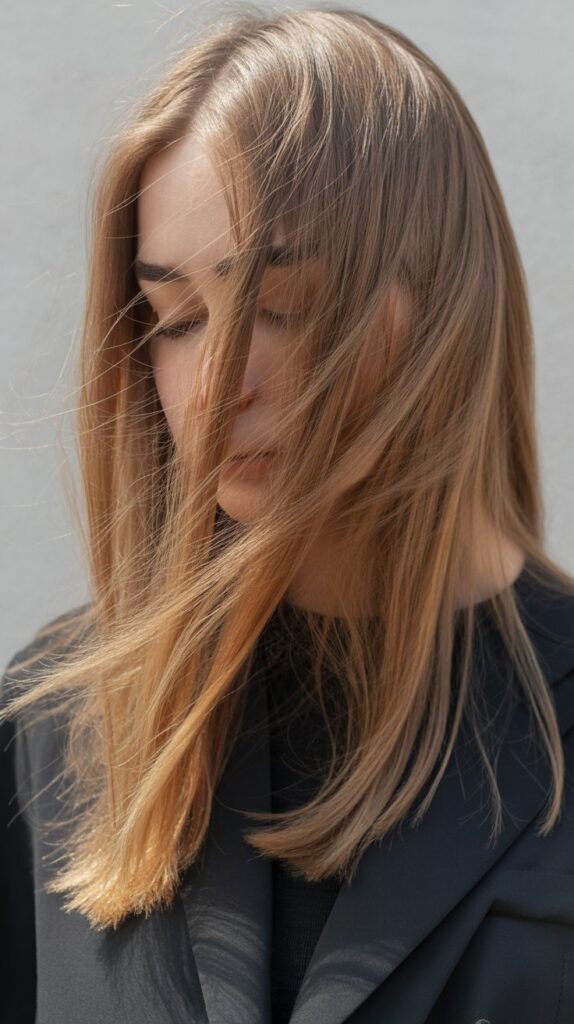
The underlayer cut features shorter layers hidden beneath longer top layers, creating volume and texture that’s revealed through movement while maintaining the appearance of length.
This hidden technique adds dimension without obvious layering.
Cutting Structure:
- The top layers remain long, creating the appearance of one-length hair when still.
- Underneath sections are cut significantly shorter, creating hidden volume and body.
- The shorter underlayers support the top layers, preventing flatness and adding fullness.
- When hair moves, the shorter layers peek through, creating dimensional interest.
Hidden Volume:
- The cut creates body from within rather than relying solely on styling products.
- Hair appears fuller and thicker due to the internal support structure.
- The underlayers prevent heavy, flat appearance common with thick, long hair.
Styling Benefits:
- Less styling effort is required as the cut provides built-in volume and movement.
- The hidden layers add swing and bounce without visible choppiness.
- Updos and ponytails gain texture and interest from the varying lengths.
29. Tapered Long Layers

Tapered long layers gradually thin toward the ends, creating a light, airy quality that reduces bulk while maintaining length.
This technique is particularly effective for thick, heavy hair that needs weight removal.
Tapering Technique:
- Hair is cut using thinning shears or razoring to reduce thickness toward the ends.
- The taper creates a gradual reduction in bulk rather than abrupt thinning.
- Ends become lighter and more delicate while the mid-lengths retain fullness.
- This prevents the bottom-heavy, triangular shape that can occur with thick, long hair.
Weight Reduction:
- The tapering removes excess weight without sacrificing length.
- Hair becomes more manageable and easier to style due to reduced bulk.
- The lighter ends move more freely and respond better to styling efforts.
Styling Ease:
- Drying time is reduced as there’s less density at the ends.
- Curls and waves hold better in tapered hair due to decreased weight.
- The hair appears more polished even with minimal styling effort.
30. Layered Fringe with Long Hair
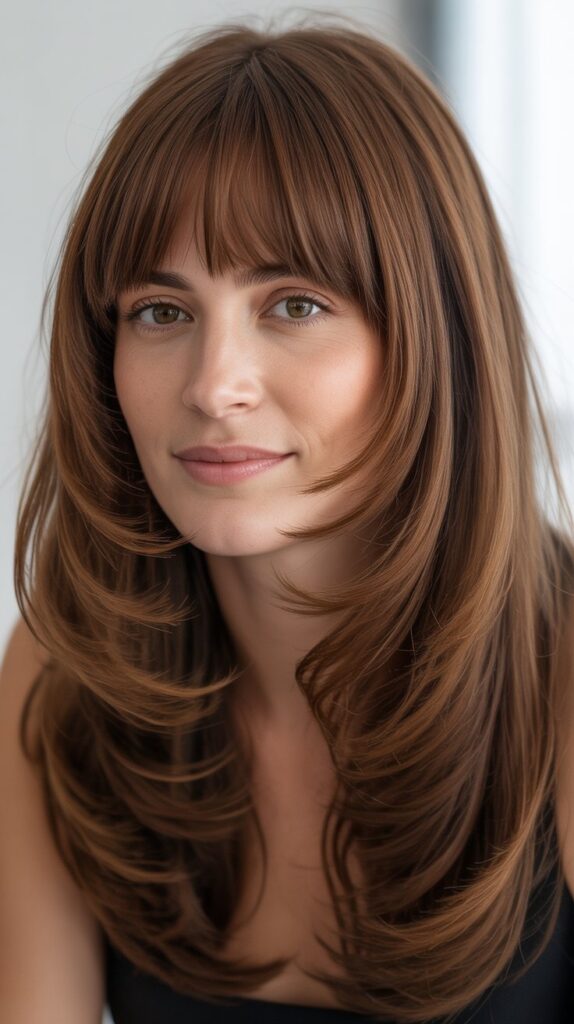
A layered fringe (bangs) combined with long hair creates a youthful, trendy look that adds personality to lengthy locks.
The fringe provides face-framing interest while the long layers add movement throughout.
Fringe Specifications:
- Bangs can range from wispy and textured to fuller and more substantial.
- The fringe is layered within itself to create texture rather than a blunt line.
- Length varies based on preference, from eyebrow-skimming to eye-length.
- The fringe blends into the first layers of the haircut for cohesive flow.
Integration with Long Hair:
- Long layers throughout the hair complement the textured fringe.
- The combination creates a balanced look with interest at both the face and throughout the length.
- This style works particularly well for those wanting to try bangs without committing to a full transformation.
Styling Requirements:
- The fringe requires daily styling to maintain its shape and texture.
- A small round brush helps create volume and shape in the bangs during blow-drying.
- The long layers can be styled straight, wavy, or curly based on preference.
- Regular bang trims every 3-4 weeks prevent the fringe from becoming too long.
31. Swooped Side Layers
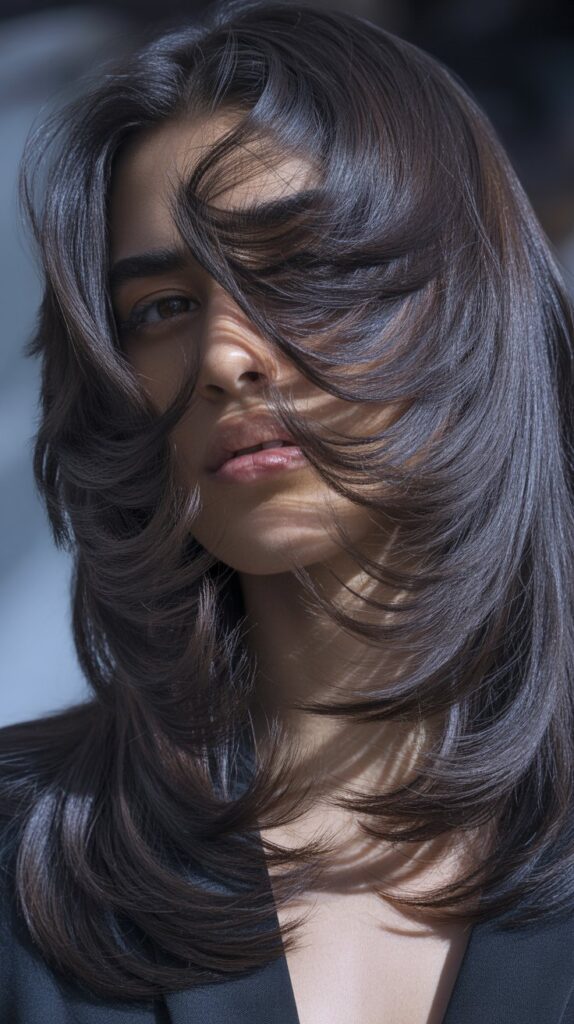
Swooped side layers feature dramatic side-swept pieces that create asymmetry and movement while keeping the overall length long. This style adds glamour and sophistication with a directional flow.
Design Elements:
- Longer layers on one side are cut to sweep dramatically across the face.
- The opposite side may feature shorter layers or be styled behind the ear for contrast.
- The swooping effect creates elegant movement and old-Hollywood glamour.
- This cut works particularly well with side parts that emphasize the sweep.
Glamorous Appeal:
- The dramatic sweep creates red-carpet worthy sophistication and elegance.
- This style photographs beautifully from every angle due to its dimensional nature.
- The swooped layers add mystery and allure by partially concealing one side of the face.
Styling Techniques:
- Blow-dry using a large round brush, directing hair in the swooping direction.
- Apply smoothing serum to enhance shine and sleekness along the swept section.
- Use a curling iron to add body and curve to the swooped layers.
- Pin the opposite side behind the ear with a decorative clip for special occasions.
32. Ribbon Layers
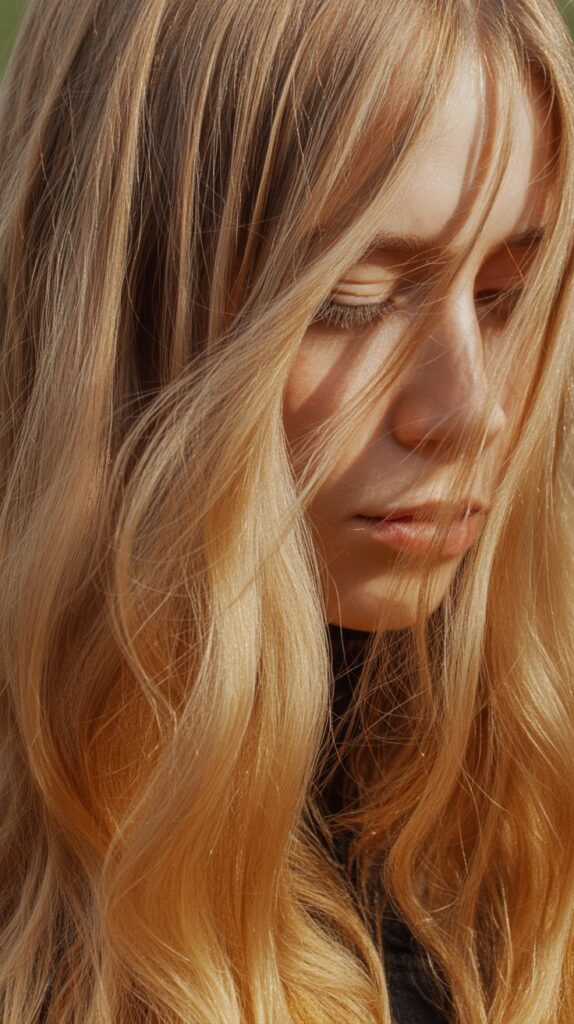
Ribbon layers create ultra-thin, delicate sections throughout long hair that resemble flowing ribbons.
This sophisticated cutting technique adds movement and lightness while maintaining substantial length.
Cutting Precision:
- Very thin sections of hair are cut slightly shorter than surrounding hair.
- These ribbon-like pieces are distributed throughout the hair for dimensional effect.
- The technique requires precision and expertise to create the delicate, ribbon-like quality.
- The thin sections catch light differently, creating subtle highlights and depth.
Movement Quality:
- The ribbon layers move independently, creating fluid, flowing motion with every turn.
- Hair appears to have more dimension and depth due to the varying thin sections.
- The delicate layers add interest without dramatically changing the overall silhouette.
Styling Approach:
- Minimal styling allows the ribbon layers to move naturally and showcase their delicate nature.
- Loose waves or curls enhance the dimensional effect of the ribbon sections.
- Avoid heavy products that would clump the delicate ribbons together.
33. Graduated Bob Transition Layers
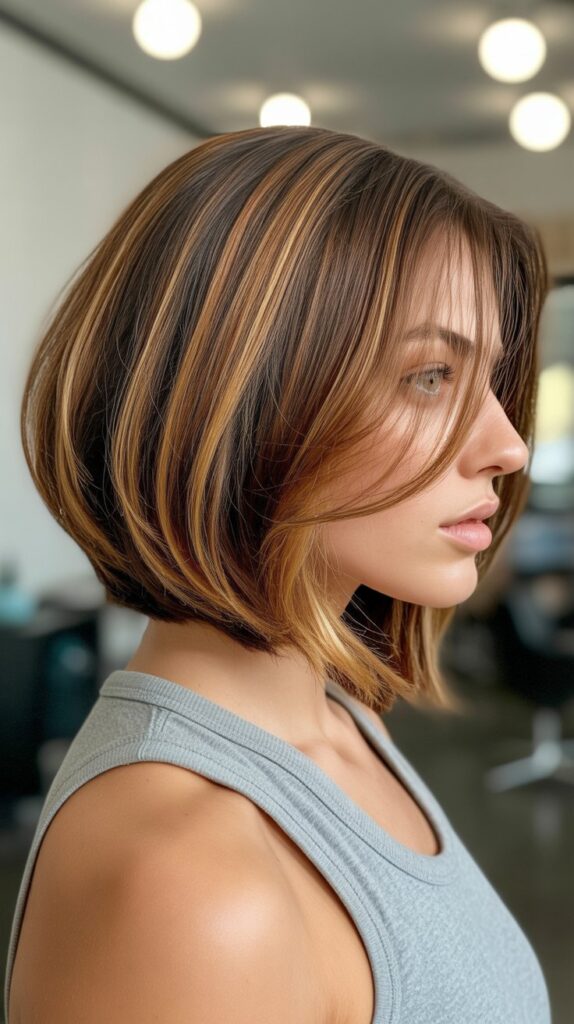
For those transitioning from a bob to long hair, graduated transition layers help blend awkward growing-out stages into an intentional style.
This technique creates cohesion during the growing process.
Transition Strategy:
- Shorter pieces from the previous bob are gradually blended into the growing length.
- Strategic layering removes the harsh line between old and new growth.
- The graduated layers create a purposeful appearance rather than an awkward grow-out look.
- This approach allows graceful transition from short to long hair.
Blending Technique:
- Layers are cut to connect shorter bob pieces with longer new growth seamlessly.
- The graduation prevents the “mullet effect” that can occur during growth phases.
- Face-framing layers are maintained to keep the style flattering during transition.
Growing Out Successfully:
- Regular transition trims every 6-8 weeks maintain the intentional graduated appearance.
- The layers can be adjusted as hair grows to continue the seamless progression.
- Eventually, the graduated layers evolve into beautiful long layered hair.
Hair Care Tips for Layered Long Hair

Maintaining healthy, beautiful layered long hair requires specific care routines that address the unique needs of layered cuts.
Hydration and Conditioning:
- Deep condition weekly, focusing on mid-lengths and ends where layers create more surface area exposed to damage.
- Use leave-in conditioner on damp hair to prevent tangling between different layer lengths.
- Apply hair masks every two weeks to maintain moisture balance throughout varying lengths.
- Choose products based on your hair texture and porosity for optimal absorption and benefit.
Heat Protection:
- Always apply heat protectant spray before using blow dryers, flat irons, or curling tools on layered hair.
- Lower heat settings on styling tools to prevent damage to the delicate shorter layers.
- Allow hair to air-dry partially before applying heat to minimize exposure time.
- Invest in quality ionic hair dryers that reduce frizz and heat damage.
Regular Maintenance:
- Schedule trims every 8-12 weeks to maintain the shape and integrity of your layers.
- Shorter layers around the face may need more frequent trims to prevent overgrowth.
- Communicate with your stylist about which layers need the most attention during maintenance cuts.
- Keep split ends at bay with regular dusting trims between major cuts.
Product Recommendations:
- Lightweight texturizing sprays enhance layers without weighing hair down.
- Volumizing mousses applied at roots lift shorter crown layers effectively.
- Smoothing serums on ends prevent frizz and maintain sleek appearance of layers.
- Dry shampoo extends time between washes while adding texture to layered styles.
Nighttime Protection:
- Sleep on silk or satin pillowcases to reduce friction and prevent tangling of different layer lengths.
- Loosely braid hair or secure in a low bun to prevent layers from becoming matted overnight.
- Avoid tight elastic bands that can create creases and breakage in delicate layers.
Styling Tools Essential for Layered Long Hair
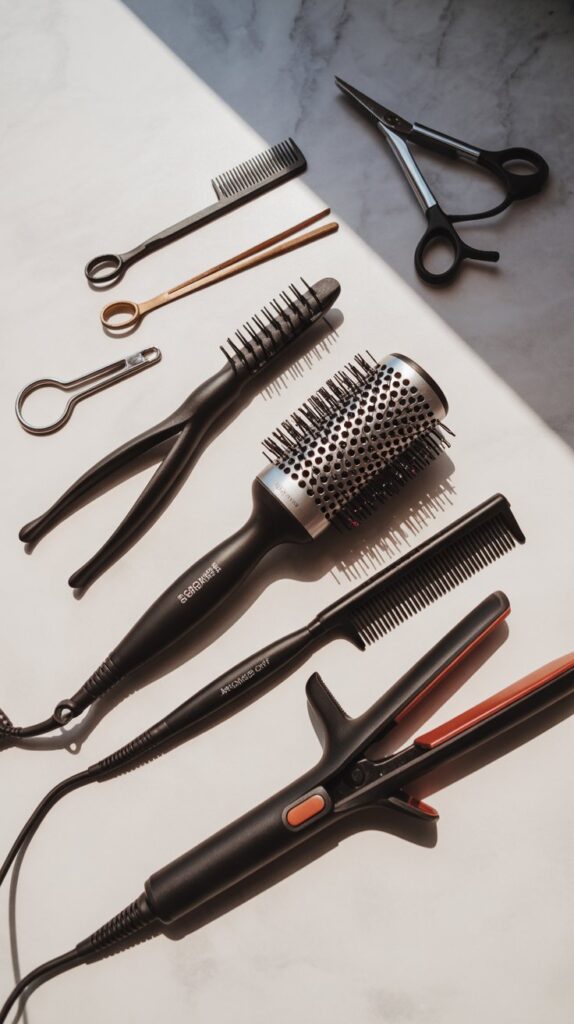
Having the right tools makes styling layered long hair significantly easier and helps achieve professional results at home.
Brushes and Combs:
- Paddle brush for detangling and smoothing one-length sections of layered hair without disrupting layer definition.
- Round brushes in multiple sizes (small for face-framing layers, large for body and volume in longer sections).
- Wide-tooth comb for gentle detangling of wet hair without pulling or breaking delicate layers.
- Teasing brush for adding volume specifically at crown layers when desired.
Heat Styling Tools:
- Quality blow dryer with multiple heat and speed settings for versatile layered styling options.
- Flat iron with adjustable temperature for straightening or creating bends in various layer lengths.
- Curling wand or iron in 1-1.5 inch barrel size, ideal for creating waves in long layered hair.
- Hot air brush combining brushing and drying for quick styling of multiple layer lengths.
Accessories:
- Sectioning clips to separate layers during styling for more precise control and definition.
- Hair ties in various sizes, with smaller ones for securing individual layer sections during styling.
- Bobby pins and hair pins for creating updos that showcase layered dimension.
- Diffuser attachment for blow dryer when styling naturally textured or curly layered hair.
Face Shape Guide for Layered Haircuts

Choosing layers that complement your face shape ensures the most flattering results and enhances your natural features.
Oval Face Shape:
- Most layer styles work beautifully with oval faces due to balanced proportions.
- Long, flowing layers emphasize the natural balance and can start at any point from cheekbones downward.
- Avoid extremely heavy layers that might overwhelm the face’s gentle curves.
- Butterfly layers, waterfall layers, and classic long layers are particularly flattering.
Round Face Shape:
- Face-framing layers starting below the chin help create the illusion of length.
- Avoid layers that end exactly at the fullest part of the face (cheeks).
- Longer layers that add height at the crown help elongate the face.
- Angled layers and diagonal forward layers create flattering vertical lines.
Square Face Shape:
- Soft, curved layers help soften angular jawlines and strong features.
- Face-framing pieces starting at the chin or slightly below draw attention away from angular jaw.
- Avoid blunt, heavy layers that emphasize the width of the face.
- Feathered layers, waterfall layers, and soft U-cut layers work exceptionally well.
Heart Face Shape:
- Layers starting at the jawline or below help balance a wider forehead.
- Avoid excessive volume at the crown, which can make the forehead appear wider.
- Face-framing layers around the jawline add width to the narrower lower portion of the face.
- Butterfly layers and curtain bangs with layers are particularly flattering.
Long Face Shape:
- Layers that add width at the sides help balance the face’s length.
- Shorter crown layers create horizontal volume rather than emphasizing vertical length.
- Avoid extremely long, straight layers that emphasize the face’s length.
- Graduated layers, flipped-out layers, and feathered layers add beneficial width.
Diamond Face Shape:
- Face-framing layers at the cheekbones and chin soften angular features and widen narrow forehead and chin.
- Layers that add fullness around the jawline balance prominent cheekbones.
- Avoid layers that end exactly at the cheekbones, which can emphasize width there.
- Curtain bangs with layers and butterfly layers are particularly flattering.
Seasonal Styling for Layered Long Hair
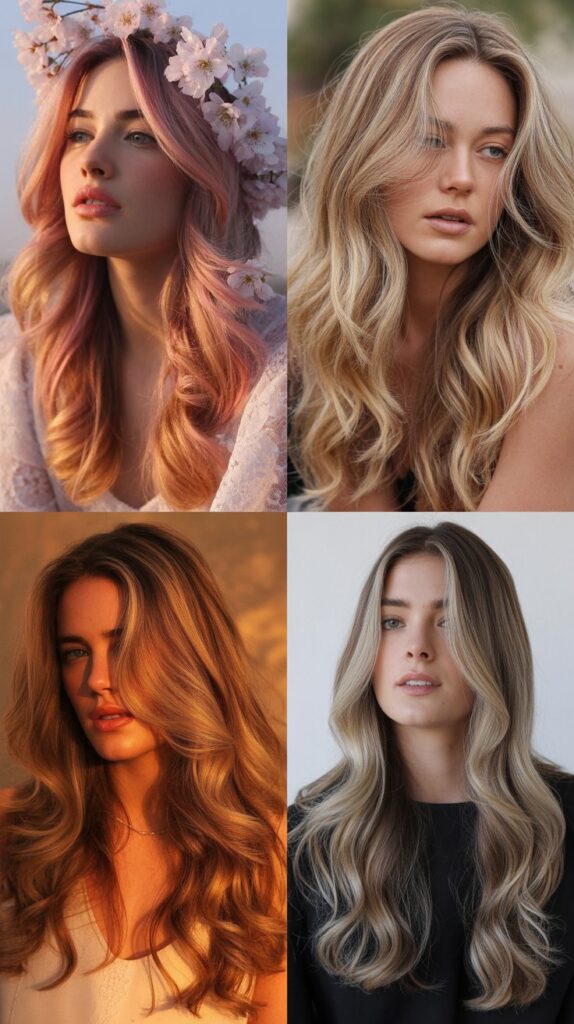
Different seasons present unique challenges and opportunities for styling long layered hair.
Spring Styling:
- Embrace natural texture as humidity increases by using texturizing products that enhance layers.
- Lighter products prevent weighing down hair as temperatures warm up.
- Incorporate braids and half-up styles that showcase layers while keeping hair off the neck.
- Floral accessories woven through layered sections create romantic spring aesthetics.
Summer Strategies:
- Protect layers from sun damage with UV-protective hair products and leave-in treatments.
- Beach waves enhance the carefree feeling of layered cuts during summer months.
- Higher updos and ponytails keep long layered hair off the neck in heat.
- Chlorine and saltwater protection is essential, with deep conditioning weekly to prevent damage.
Fall Transitions:
- Richer, deeper tones complement layered cuts beautifully as autumn approaches.
- Add subtle highlights that catch fall light and enhance layer dimension.
- Sleeker styling works well as humidity decreases and hair becomes more manageable.
- Incorporate scarves and headbands that work with layered textures.
Winter Care:
- Combat static and dryness with intensive moisture treatments focused on layered ends.
- Use anti-frizz products to manage indoor heating effects on layers.
- Protect hair from cold winds with silk-lined hats that won’t damage layers.
- Volumizing techniques help prevent flat, limp appearance from heavy winter clothing.
Celebrity-Inspired Layered Looks
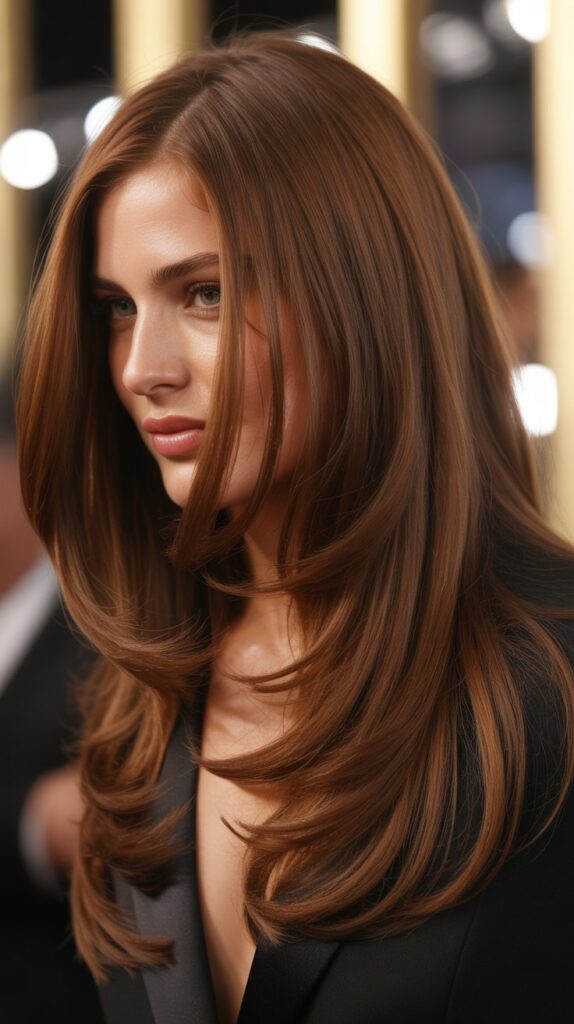
Many celebrities have made long layered haircuts iconic, providing inspiration for your next salon visit.
Classic Hollywood Layers:
- Jennifer Aniston’s signature layers from the early 2000s continue to inspire with their face-framing perfection and effortless movement.
- These classic layers typically start at the collarbone with longer pieces extending down the back.
- The cut emphasizes shine and health, requiring excellent hair condition to pull off successfully.
- Styling involves blow-drying with a round brush for body and finishing with shine serum.
Modern Butterfly Layers:
- Popularized by numerous celebrities and influencers on social media platforms in 2024-2025.
- This dramatic cut creates the most impact when styled with loose waves or curls.
- The shortest layers frame the face while maintaining substantial length at the back.
- This style photographs exceptionally well, making it a favorite for events and photoshoots.
Bohemian Flowing Layers:
- Inspired by festival fashion and free-spirited aesthetics seen on musicians and artists.
- These layers embrace natural texture and appear effortlessly undone yet intentionally styled.
- The cut works best with some natural wave or curl to enhance the bohemian vibe.
- Minimal styling products maintain the natural, lived-in appearance.
Sleek Sophisticated Layers:
- Celebrity red-carpet looks often feature polished, sleek layered styles with glossy finishes.
- These layers are often subtle and internal, maintaining a smooth exterior appearance.
- Professional styling with flat irons and smoothing products achieves the glass-like shine.
- This elegant approach works well for formal events and professional settings.
Budget-Friendly Layered Hair Maintenance
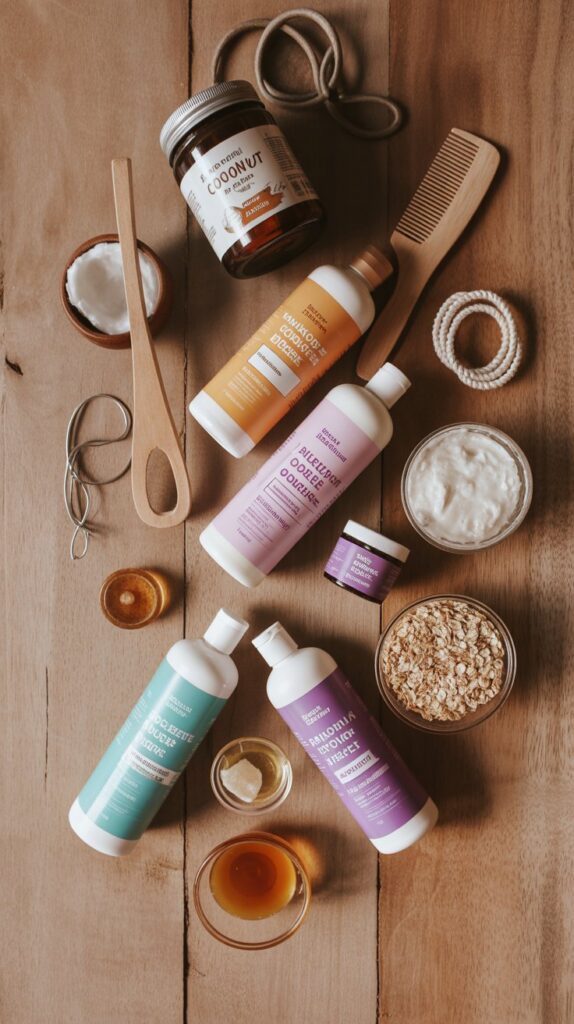
Maintaining beautiful long layered hair doesn’t require expensive products or frequent salon visits with these smart strategies.
At-Home Care Solutions:
- Create your own deep conditioning treatments using natural ingredients like coconut oil, avocado, and honey for intensive moisture without the salon price.
- Invest in one quality heat protectant spray that serves multiple purposes rather than buying specialized products for each tool.
- Learn basic trimming techniques for maintaining face-framing layers between professional cuts, though major cuts should remain with professionals.
- Use drugstore alternatives to expensive salon products by reading ingredient lists and choosing similar formulations.
Extending Salon Visits:
- Properly maintained layers can last 10-12 weeks between cuts rather than the typical 6-8 weeks.
- Focus salon visits on reshaping and removing damaged ends while maintaining layers at home between visits.
- Communicate with your stylist about a cut that grows out gracefully and requires less frequent maintenance.
- Schedule maintenance cuts during slower salon periods when prices might be reduced.
Product Efficiency:
- Use less product than recommended initially and build up only if needed to avoid waste.
- Focus expensive products only on the most visible layers around the face.
- Generic or store-brand styling products often work as well as premium brands for basic styling needs.
- Share products with family members or friends who have similar hair types to reduce individual costs.
DIY Styling Techniques:
- Master blow-drying techniques at home to reduce reliance on professional blowouts.
- Watch tutorial videos specific to layered hair to learn professional styling techniques.
- Invest in quality tools once rather than repeatedly buying cheap tools that break.
- Practice on weekends when you have time to perfect techniques without pressure.
Conclusion
The journey through these Top 30+ Stunning Haircut Ideas for Long Hair in 2025 reveals the incredible versatility and beauty that long layered hairstyles offer to anyone seeking transformation without sacrificing length.
From classic long layers that have stood the test of time to trending butterfly layers taking social media by storm, each style presents unique opportunities to express your personality and enhance your natural features.
Whether you’re drawn to the romantic flow of waterfall layers, the edgy appeal of choppy textures, or the sophisticated elegance of sleek one-length cuts with subtle layering, there’s a perfect option waiting for you.
Remember that the most flattering haircut considers your face shape, hair texture, lifestyle, and maintenance commitment, so consult with a skilled stylist who can customize these ideas to suit your individual needs.
With proper care, quality products, and regular maintenance, your new long layered haircut will keep you looking stunning and feeling confident throughout 2025 and beyond.
Take inspiration from these diverse options, save your favorites, and embark on your hair transformation journey with excitement and confidence.
